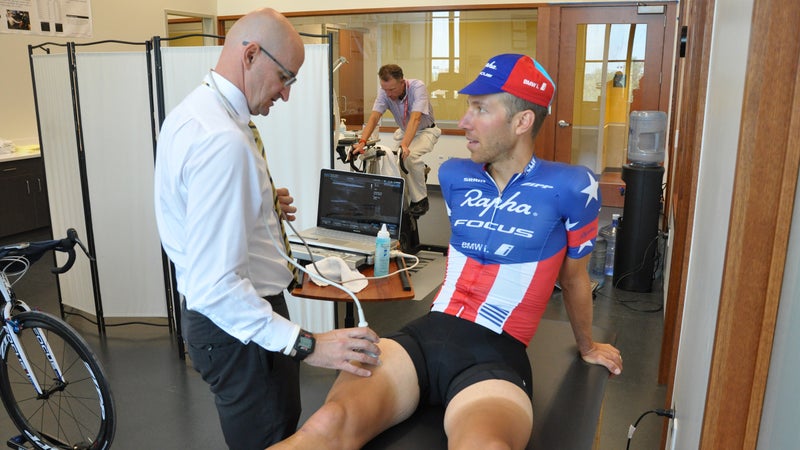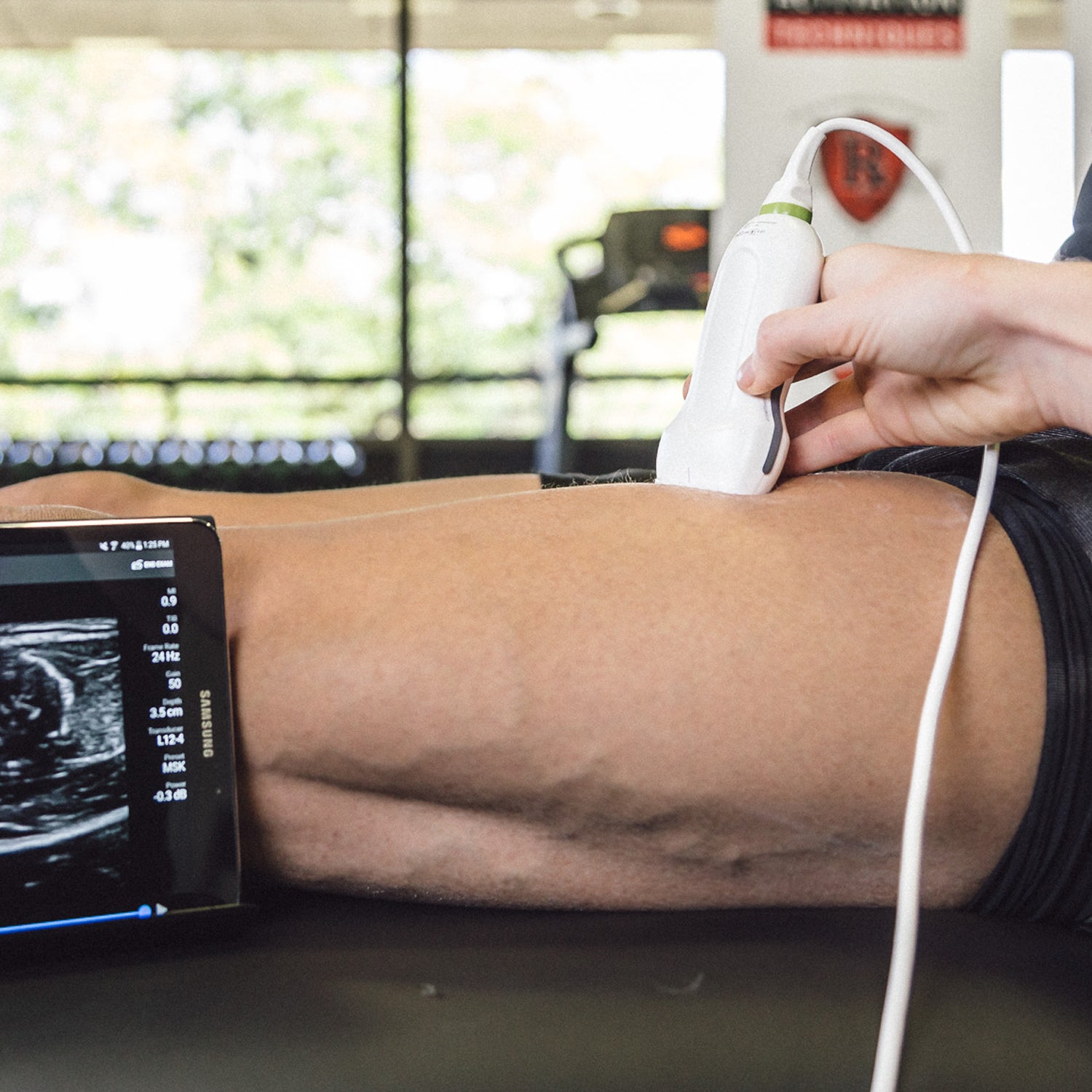Over the past few months, in Boulder, Colorado, a growing number of elite athletesŌĆöincluding four-time U.S. cyclocross champion Jeremy Powers and Rio Olympic medalists Jenny Simpson (800-meter run) and Emma Coburn (steeplechase)ŌĆöhave added a new element to their training routines. At the end of a long day, after theyŌĆÖve showered and refueled, these athletes wave a three-inch wand over their major leg muscles. On an adjacent screen, an image appears that, at first glance, looks like an ultrasound scan. Shortly thereafter appears a numerical score between zero and 100, which corresponds to the athleteŌĆÖs level of glycogen, the bodyŌĆÖs predominant fuel source for muscular energy. This new tool, called MuscleSound, is supposed to quantify the fine line between optimal and overtraining, revealing insights into the body that previously were left to imprecise estimates.
The MuscleSound score is closely linked to carbohydrates, which the body converts to muscle glycogen and thus┬Ā when it comes to a high-performance diet. The idea behind this new device is that by monitoring glycogen over a typical training week, an athlete can find the right balance between carb intake and training workload. A chronically low score means the athlete should either eat more carbohydrates or decrease training intensity and duration. If the reading is consistently 100, however, the athlete may actually need to cut back on carbohydrate intake, since carbs get turned into fat when muscle glycogen is topped off. (The body can store only about one poundŌĆÖs worth of carbohydrates.) For a long time, measuring muscle glycogen required removing about a cubic square inch of muscle and analyzing it in a specialized lab. The procedure, called muscle biopsy, is invasive, expensive, and wholly impractical for regular use by athletes.
MuscleSound founder , one of the worldŌĆÖs foremost experts in carbohydrate metabolism, thought he could design a safer, easier way to achieve the same results. San Mill├Īn first became interested in sports nutrition more than 20 years ago while completing his PhD in exercise physiology at the University of the Basque Country, in northern Spain. , elite athletes then were experimenting with carbohydrate-restricted training. ŌĆ£We did all sorts of exercise testing, and it quickly became evident that carbohydrates were really important,ŌĆØ recalls San Mill├Īn. (Decades later, are still coming to the same conclusion, despite the popularity of LCHF diets.) ŌĆ£But exactly how many carbs an athlete needed and the timing of when those carbs should be eaten was a mystery.ŌĆØ
This new tool allows athletes to quantify the fine line between optimal and overtraining.
In 2008, shortly after San Mill├Īn started working at the University of Colorado, where heŌĆÖs currently a professor in the School of Medicine and director of the Sports Medicine and Performance Center, he sought out a physician named , one of the first sports medicine doctors in the United States to experiment with musculoskeletal ultrasound, a technology that uses ultrasonic sound waves to generate images of muscle. Used primarily as a diagnostic tool and guide for therapeutic injections, musculoskeletal ultrasound is quick, noninvasive, and, compared to other medical technologies, relatively inexpensive. ŌĆ£When I first got to Colorado,ŌĆØ says San Mill├Īn, ŌĆ£I introduced myself to Hill, and I think the next thing I said was, ŌĆśThereŌĆÖs got to be a way to measure muscle glycogen using ultrasound.ŌĆÖŌĆØ
When you send a sound beam into the body, it bounces back differently depending on the structure it hits. Muscles are relatively straightforward: they contain connective tissue, fascia, and muscle fibers, all of which generate unique sound beams and ultrasonic images. But when a sound beam makes contact with water, San Mill├Īn says, it disappears and never bounces back. As it happens, one gram of glycogen contains three grams of water, and this, the duo thought, could be the pathway to a measurement.
San Mill├Īn and Hill began tinkering. ŌĆ£When a muscle was full of glycogen, the ultrasound produced images of the connective tissue and fascia, but you could hardly see any muscle fibers,ŌĆØ says San Mill├Īn. ŌĆ£They were hidden by the water in the muscle.ŌĆØ But after San Mill├Īn and Hill had athletes deplete their muscle glycogen stores with a long, hard workout, the water disappeared, exposing lots of muscle fibers. The more muscle fibers visible on the ultrasound, the less glycogen in the muscle. ŌĆ£ThatŌĆÖs how we quantify it,ŌĆØ San Mill├Īn says, with a sort of giddy enthusiasm. ŌĆ£We developed software that spits out a glycogen score based on the ultrasound reading. ItŌĆÖs like a fuel gauge on your car.ŌĆØ
In 2014, the duo measured athletesŌĆÖ muscle glycogen contents before and after exercise using both muscle biopsy and their technology. Their results, in Physician and Sports Medicine in 2014, showed an almost perfect correlation. They then commissioned a team of third-party scientists from Appalachian State UniversityŌĆÖs Human Performance Lab to replicate their study, who┬Āalso between muscle biopsy and San Mill├Īn and HillŌĆÖs technology. A year later, MuscleSound was born.

The technology is currently compatible with Android devices and can be for $5,000 or rented for $200 a month, although San Mill├Īn expects the price to come down over time. The kit is easily transported, so it can be used just about anywhere. Though that price point may make MuscleSound too expensive for most of us, itŌĆÖs within reach of institutions and teams. The Dallas Mavericks and Colorado Rockies , as do other teams from the NFL, NBA, NHL, MLS, and MLB, according to San Mill├Īn. Last year, USA Cycling used MuscleSound as a part of its effort to harness cutting-edge sports science in the buildup to the Olympics.
Athletes using the device today are learning how many grams of carbohydrates they need to support each and every type of training session. The technology also helps with training readiness (a low glycogen score might mean delaying a key workout), prevents overtraining (consecutive days of low scores mean you better back off), and enhances pre-event carbohydrate loading (stop stuffing yourself once your score is nearing 100).
ŌĆ£San Mill├ĪnŌĆÖs new technology is a very useful tool in our kit of resources,ŌĆØ says Mark Wetmore, the running coach who trains Coburn and Simpson, as well as the University of ColoradoŌĆÖs cross-country team, which uses the data to make real-time training adjustments. ŌĆ£To measure glycogen stores in the past, one had to have a hole gouged deep into some big muscle,ŌĆØ Wetmore says. ŌĆ£How often do you want to do that during the training and racing season? Now we can have an accurate reading of an athleteŌĆÖs recovery from training, or readiness for racing, in just a few minutes.ŌĆØ
The technology also helps with training readiness, prevents overtraining, and enhances pre-event carbohydrate loading.
MuscleSound has been put to use among nonathletes as well. Many hospital patients in intensive care units develop what is called ICU-acquired weakness, or a chronic full-body fatigue caused in part by improper nutrition. Literally fighting for their lives day after day, ICU patients enter a catabolic state, or a condition of constant muscle wasting and breakdown. ŌĆ£ItŌĆÖs like they are running a marathon that never ends, but without sound nutritional support,ŌĆØ says , the associate vice chair for clinical research at Duke, and a former a critical care physician at the University of Colorado Hospital who once ran competitively and worked as a personal trainer.
Once MuscleSound was clinically validated, San Mill├Īn shared the technology with Wischmeyer. It wasnŌĆÖt long before the duo started using it with ICU patients. What they found was striking: most of the patients they scanned had zero glycogen in their muscles. (Wischmeyer says that even after finishing an ultramarathon, runners typically have between 15 and 25 percent of their glycogen stores.) Their revelation has profound implications. ŌĆ£Many of my colleagues realized they were administering therapies meant to help patients but that were actually hurting them instead because [the patients] were so catabolic,ŌĆØ says Wischmeyer, referring to therapies based on derivatives of testosterone, which are often given to ICU patients in hopes of building them back up. According to Wischmeyer, if a patient has no muscle glycogen, these drugs can cause grave harm and even prove fatal. Using insights gleaned from MuscleSound, Wischmeyer and San Mill├Īn recently published a paper in the journal Critical Care titled ŌĆ£.ŌĆØ
Their hope: that MuscleSound will bring more visibilityŌĆöquite literallyŌĆöto the issue.


